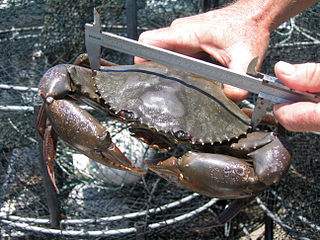
Leyte Gulf is a gulf in the Eastern Visayan region in the Philippines. The bay is part of the Philippine Sea of the Pacific Ocean, and is bounded by two islands; Samar in the north and Leyte in the west. On the south of the bay is Mindanao Island, separated from Leyte by the Surigao Strait. Dinagat Island partly encloses the gulf to the southeast, and the small Homonhon Island and Suluan Island, sit astride the eastern entrance to the Gulf. It is approximately 130 km (81 mi) north-south, and 60 km (37 mi) east-west.

Mudflats or mud flats, also known as tidal flats or, in Ireland, slob or slobs, are coastal wetlands that form in intertidal areas where sediments have been deposited by tides or rivers. A global analysis published in 2019 suggested that tidal flat ecosystems are as extensive globally as mangroves, covering at least 127,921 km2 (49,391 sq mi) of the Earth's surface. They are found in sheltered areas such as bays, bayous, lagoons, and estuaries; they are also seen in freshwater lakes and salty lakes alike, wherein many rivers and creeks end. Mudflats may be viewed geologically as exposed layers of bay mud, resulting from deposition of estuarine silts, clays and aquatic animal detritus. Most of the sediment within a mudflat is within the intertidal zone, and thus the flat is submerged and exposed approximately twice daily.
Five vessels of the British Royal Navy have been named HMS Scylla, after the sea monster Scylla of Greek mythology.

Scylla serrata is an ecologically important species of crab found in the estuaries and mangroves of Africa, Australasia, and Asia. In their most common forms, their shell colours vary from a deep, mottled green to very dark brown.
Scylla is a monster from Greek mythology traditionally located at today's town of Scilla, Calabria.

Chilli crab is a Southeast Asian seafood dish that originated in Singapore in the 1960s. It is widely associated as the national cuisines of both Malaysia and Singapore. Mud crabs are commonly used and are stir-fried in a semi-thick, sweet and savoury tomato-and-chilli-based sauce.

Scylla paramamosain is a mud crab commonly consumed in Southeast Asia.

Portunus pelagicus, also known as the flower crab, blue crab, blue swimmer crab, blue manna crab or sand crab, rajungan in Indonesian, and alimasag in Tagalog, Kapampangan, and Pangasinan, is a large crab found in the intertidal estuaries around most of Australia and east to New Caledonia.

Portunidae is a family of crabs which contains the swimming crabs.

Crab fisheries are fisheries which capture or farm crabs. True crabs make up 20% of all crustaceans caught and farmed worldwide, with about 1.4 million tonnes being consumed annually. The horse crab, Portunus trituberculatus, accounts for one quarter of that total. Other important species include flower crabs, snow crabs (Chionoecetes), blue crabs, edible or brown crabs, Dungeness crab, and mud crabs, each of which provides more than 20,000 tonnes annually.

In anatomy, an eyestalk is a protrusion that extends an eye away from the body, giving the eye a better field of view. It is a common feature in nature and frequently appears in fiction.

The Grass Mud Horse or Cǎonímǎ is a Chinese Internet meme based on a pun. Homophonic puns in Standard Chinese delight many Chinese people, and they have become an important component of Chinese culture.
Hematodinium is a genus of dinoflagellates. Species in this genus, such as Hematodinium perezi, the type species, are internal parasites of the hemolymph of crustaceans such as the Atlantic blue crab and Norway lobster. Species in the genus are economically damaging to commercial crab fisheries, including causing bitter crab disease in the large Tanner or snow crab fisheries of the Bering Sea.

Scylla tranquebarica is a species of mangrove crab in the genus Scylla. Scylla tranquebarica, one of several crabs known as the mud crab, is found in mangrove areas from Pakistan and Taiwan to the Malay Archipelago and other Indo-Pacific regions.

Scylla is a genus of swimming crabs, comprising four species, of which S. serrata is the most widespread. They are found across the Indo-West Pacific. The four species are:

The Panopeidae are a family containing 26 genera of morphologically similar crabs, often known as "mud crabs". Their centers of diversity are the Atlantic Ocean and eastern Pacific Ocean.
The Baidu 10 Mythical Creatures, alternatively Ten Baidu Deities, was initially a humorous hoax from the interactive encyclopedia Baidu Baike which became a popular and widespread Internet meme in China in early 2009.

Koggala Lagoon is a coastal body of water located in Galle District, Southern Sri Lanka. It is situated near the town of Koggala and adjacent to the southern coast, about 110 km (68 mi) south of Colombo. The lagoon is embellished with eight ecologically rich small islands.

Scylla olivacea, commonly known as the orange mud crab, is a commercially important species of mangrove crab in the genus Scylla. It is one of several crabs known as the mud crab and is found in mangrove areas from Southeast Asia to Pakistan, and from Japan to northern Australia. Along with other species in the genus Scylla, it is widely farmed in aquaculture using wild-caught stocks. They can be differentiated from other species of Scylla by having blunted spines on the dorsal distal corner of the palm (propodus) of the claw, and by the rounded frontal lobe spines with shallow separations in between the eyes.













